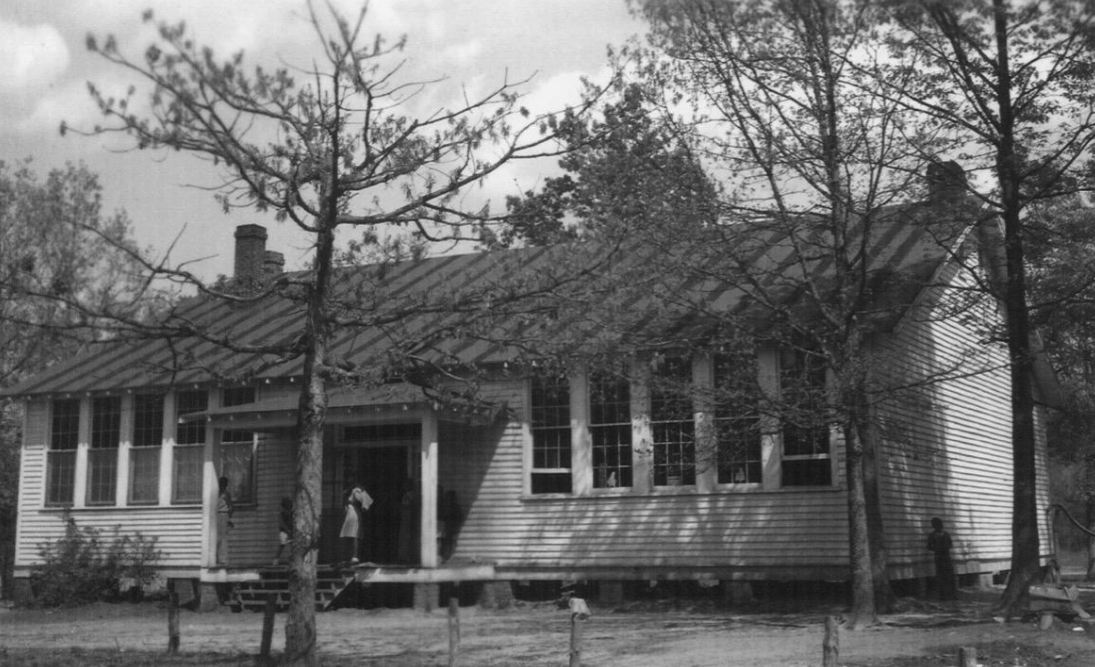From Tuskegee to East Flat Rock: The Rosenwald Schools
/Above Alex Schenck, left, and Scotty Scott, right, with an unnamed soldier in between. Image courtesy of the author.
Isadore “Scotty” Scott and my father-in-law, Alex Schenck, met in a fox hole in World War II. Both second lieutenants, the most disposable officer in the war, the two men became lifetime best friends whose families shared many interests including philanthropy and fly fishing. After the war, Scotty married Joanie Rosenwald, the granddaughter of Julius Rosenwald, the philanthropist responsible for the Rosenwald Fund school initiative.
It was on one of their visits to Flat Rock that I first learned about the Rosenwald Schools. It sparked my interest as an educator, and the history detective in me was curious. It was the beginning of a fascinating exploration including interviews with Rosenwald family members.
——
The Rosenwald Schools are the inspiring story of two hardworking, successful men who gave back to the country in which they prospered. Conceived by African American educator Booker T. Washington and his Tuskegee Institute staff, the Rosenwald School project was a massive effort to improve black rural schooling in the Jim Crow-era South when minority students received vastly inferior education and sometimes no education at all. During this time of discrimination and racial segregation, Washington partnered with philanthropist Julius Rosenwald, part-owner and president of Sears, Roebuck and Company, to offer matching grants to rural communities interested in building black schools through a public-private collaboration.
Julius Rosenwald
Above, photo of Julius Rosenwald and Booker T. Washington that hangs at Tuskegee. Image courtesy of Erika Scott.
Julius Rosenwald was born on August 12, 1862, in Springfield, Illinois, the son of German-Jewish immigrants. His father had risen from peddler to partner in a clothing concern. Known to his friends as “JR,” he apprenticed for his uncles, who were major clothing manufacturers in New York City. As a men’s clothing salesman, he became a leading supplier to the growing business of Sears, Roebuck and Company, which he eventually fashioned into the largest mail-order enterprise in the world. In 1895, he became one of its investors, eventually serving as president of Sears from 1908 to 1922 and chairman until his death in 1932. With the personal fortune he amassed, he developed into one of America’s leading philanthropists. Rabbi Emil Hirsch of Chicago Sinai Congregation influenced JR to use his great wealth and leadership to improve the world — to practice what is known in the Jewish community as tzedakah, a Hebrew word meaning “righteousness” but commonly used to signify charity, an ethical obligation that the Torah mandates as part of the roots of Jewish philanthropy.
Booker T. Washington
Born into slavery, Booker T. Washington was the son of Jane, an African-American slave in Virginia. After emancipation, she moved her family to West Virginia, a free state, to join her husband, Washington Ferguson, who had escaped from slavery during the war. As a young man, Booker T. Washington worked his way through Hampton Normal and Agricultural Institute, now Hampton University, and attended college at Wayland Seminary, now Virginia Union University. In 1881, he was named as the first president of the new Tuskegee Institute in Alabama, founded for the higher education of African Americans. He developed the college from the ground up, enlisting students in construction of the buildings, classrooms and dormitories. Work at the school was considered fundamental to students’ higher education.
Washington became a popular spokesperson for African-American citizens and gained the respect of many American leaders including presidents Theodore Roosevelt and William Howard Taft. Washington’s efforts included collaborating with white people and enlisting the support of wealthy philanthropists such as Andrew Carnegie, George Eastman, John D. Rockefeller, and Henry Huttleston Rogers for his causes. He gave a speech, “The Atlanta Compromise,” that brought him national fame. It called for black progress through education rather than directly challenging Jim Crow segregation.
The Rosenwald Fund
Julius Rosenwald. Image courtesy of Erika Scott.
Rosenwald supported a number of philanthropic causes, but it was Washington’s book, Up from Slavery, that generated his interest in charitable works for African American education in the South. The two met in 1911 at a luncheon in Chicago and Rosenwald soon became a trustee of Tuskegee Institute, a position he held until his death. Washington encouraged Rosenwald to not only help with higher education offered at Tuskegee but also to address the state of black elementary schools throughout the South.
The two men collaborated on a pilot program with Tuskegee architects to design six model schools for African American students in rural areas of the South, the first ones to be built in Alabama near Tuskegee. Rosenwald conditioned his support on the buy-in of the local African American community to raise its own funds to match his gift and to encourage local commitment to these projects. To promote collaboration between black and white people, Rosenwald required white governing bodies to also commit public funds and/or labor to the schools, as well as to contribute additional cash donations after construction. His intention was to foster a coming together of the white and black segments of rural communities to provide adequate schools for young children.
The East Flat Rock Rosenwald School. Image courtesy of Henderson County Genealogy and Historical Society.
In 1913, the first Rosenwald School was dedicated in Alabama. By the time Booker T. Washington died in 1915, Rosenwald had already given matching funds for some 80 black schools in three states. In 1917, Rosenwald established The Rosenwald Fund for “the well-being of mankind.” Unlike other endowed foundations, Rosenwald specified that all of its funds were to be used for philanthropic purposes within 15 years after his death. Rosenwald’s great-great-granddaughter, Erika Scott, shared with me her grandfather’s belief in the importance of giving in the present to make an impact on the future: “He was a practical man whose generosity and wisdom transformed the practice of philanthropy: to give while you live.” Erica’s father, Jonathan Scott, added, “He was a very humble man and refused to have his name attached to the buildings or projects he endowed, yet his passionate support of Jewish and African American causes continues to influence lives today. He encouraged communities to take ownership of their endeavors.”
Within 20 years, thousands of old shanty schoolhouses had been replaced with new structures. By 1920, the construction program was more than Tuskegee could handle, so Julius Rosenwald created a Rosenwald Southern Office in Nashville, Tennessee, and hired Samuel Leonard Smith to run it. One of Smith’s first assignments was to design a series of stock blueprints for any rural community to build a top-flight school facility without architectural fees. Initially, plans were issued one at a time in a four-page pamphlet, but demand proved so great that in 1924, the Southern office published a book, Community School Plans. The book included plans for 17 schools ranging in size from structures having one teacher to those having seven teachers. Once a community selected its plans, detailed blueprints and specifications could be obtained. Originally, the schools had no electricity, and to maximize natural light the plans included large windows and structure placement. In her travels to see Rosenwald Schools, Erika Scott, noted that “once you get an eye for a Rosenwald School, you recognize them, especially the window design.”
The Potts sisters, Hortense and Fredricka. Image courtesy of Hortense Potts.
East Flat Rock Rosenwald School
Gone but not forgotten is the Rosenwald School of East Flat Rock. Built in 1922, it was the only Rosenwald School in Henderson County. Last year when I was writing about the African American history of Henderson County, I had the opportunity to interview Hortence Potts. She was sharp as a tack for her 94 years and totally captivated me with her family heritage. Her sister, Fredericka, was 101 years old and according to Hortense was “slowing down a bit.” The two sisters live in their family home, Brook Ledge, built in 1900 by their father, Fred Potts, a noted horticulturist. He bought his homestead in East Flat Rock when he was a teenager while working in Asheville. “My parents were very proud, hardworking people with clean livers,” said Hortense. “I’m especially proud of my father. He never met a stranger and could talk the horns off a bull! He had little formal education, but he became a well-educated man. He knew all the botanical names of plants and flowers.”
National Trust for Historic Preservation
In 1954 when the Supreme Court declared segregation unconstitutional, Rosenwald Schools became obsolete. Once the pride of their communities, many were abandoned, burned, or demolished. Despite the schools’ historical significance, only a small percentage of Americans are familiar with the Rosenwald Schools and their impact on our nation’s history.
In 2002 the National Trust for Historic Preservation joined forces with local communities to help preserve these beacons of African American education. Of the 5,357 schools, shops, and teacher homes built, only about 12 percent still exist. In addition to the National Trust’s efforts to raise awareness and provide assistance, local governments and churches along with grassroots activists are finding creative uses for the buildings.
Image courtesy of the Rowell Bosse North Carolina Room, Transylvania County Library
In Transylvania County, the Brevard Rosenwald School opened its doors to black students a little more than a century ago. Alumni today credit the school’s strategy as one reason they have enjoyed a life of community participation. In her book, The Brevard Rosenwald School, Betty J. Reed says, “Wisely, Rosenwald sponsored innovation only in communities willing to collaborate in school construction. His practice challenged the African American population to raise money, to volunteer labor, and to enlist the assistance of the white community. The improved school facility was not a gift. Rather, it was an achievement in which each citizen could take pride.” Today, renovated and repurposed, the former Brevard Rosenwald School houses the Transylvania County central education offices.
A lifetime legacy
Reconnecting with Jonathan and Erika Scott, the great-grandson and great-great-granddaughter of Julius Rosenwald, was very special. As descendants of Julius Rosenwald they were able to share personal experiences and stories about this family icon. I asked both of them individually if there was a particular event that stood out in their memory about their relative. Interestingly, they both shared a similar story.
“Soon after J.R. partnered with Booker T. Washington, he took his family on a train from Chicago to Alabama to see Tuskegee Institute. When they walked on the campus, they were the only white people there. It was an eye-opening experience for his wife and children. For the first time in their lives, they understood what it felt like for a black person to be in a totally white community. When I visited Tuskegee about 15 years ago, I realized what a different culture my great-great-grandfather had walked into at Tuskegee. He was willing to step out of his own community and help a group of people he was not even connected to — he saw a need and he met it. He is my hero for that,” said Erika.
“When I was about nine or ten years old, my grandfather, Lessing Rosenwald, the son of Julius, took all of his children and grandchildren on the train from Philadelphia where we lived to Alabama to see the Tuskegee Institute. His own father had done the same thing for his family when he was a boy,” recalled Jonathan. “When we arrived on campus, we were the only white people there. It was the first time in my life I experienced these feelings and felt the magnitude of my great grandfather’s legacy. There was a real sense of pride knowing he opened a door to African American education in the South — and by doing so, he instilled in our family the true meaning of tzedakah.”
—-
Information for this article was obtained by referencing the published works of Betty J. Reed, Terry Ruscin, Stephanie Deutch, Peter Askoli, Jennifer Giles, Bold Life, N.C. Museum of History, Wikipedia, the National Trust for Historic Preservation, the Raleigh News and Observer, and the Hendersonville Times-News.
About the Author:
Missy Craver Izard Schenck was born and raised in Charleston, South Carolina. She resides in Flat Rock, North Carolina with her husband, Sandy Schenck, where their family runs a summer camp.









